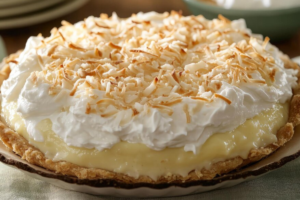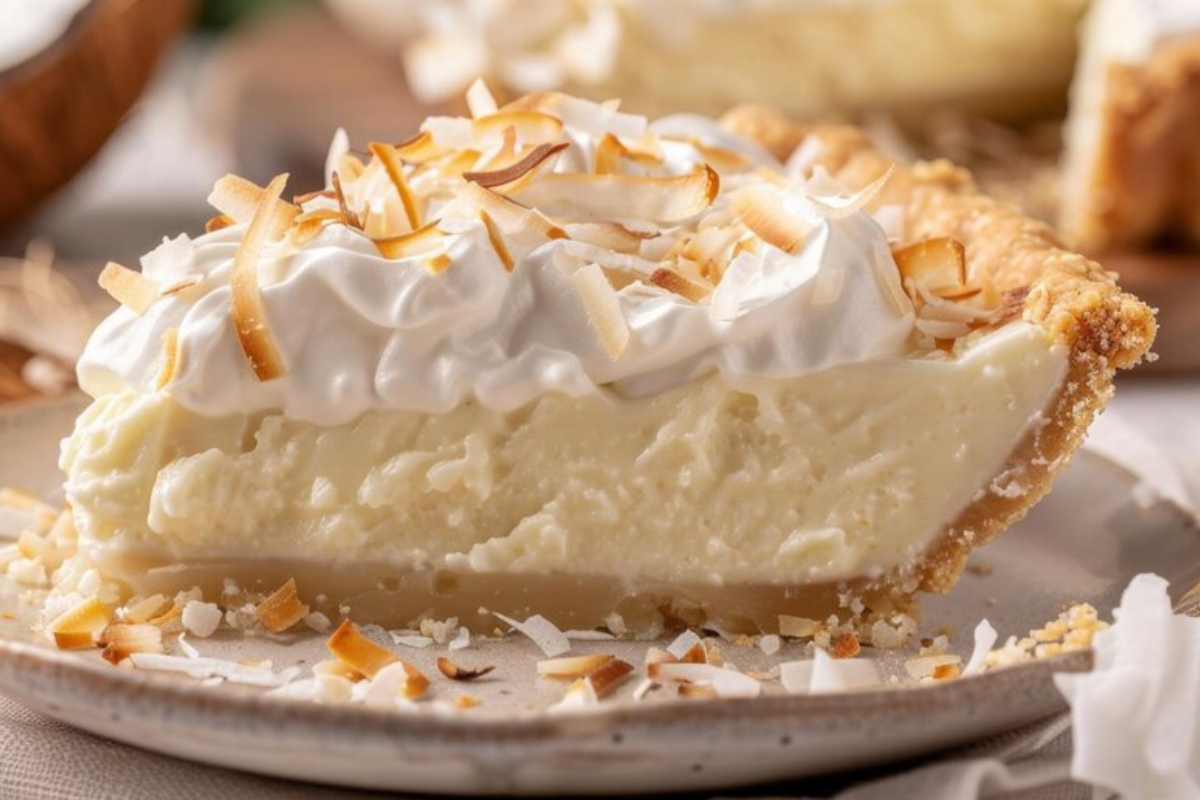Coconut cream pie is an iconic dessert loved for its rich, creamy filling and flaky crust. However, one of the most frustrating challenges home bakers face is the filling becoming watery or runny after it cools. Nothing spoils a beautiful coconut cream pie more than a watery center, turning your culinary masterpiece into a disappointing puddle.
This detailed guide will help you understand why your coconut cream pie gets watery and provide expert tips to prevent it. We’ll explore common mistakes, essential steps, and little-known tricks for creating the perfect coconut cream pie every time.
Table of Contents
- Understanding the Basics: Why Coconut Cream Pie Gets Watery
- The Role of Ingredients in Preventing Watery Filling
- Step-by-Step Guide to Avoid a Watery Coconut Cream Pie
- Tips for Baking the Perfect Coconut Cream Pie Crust
- Thickening Agents: Which One is Right for Your Pie?
- Proper Cooling and Storage to Maintain Texture
- Common Mistakes and How to Fix Them
- FAQs: Everything You Need to Know About Coconut Cream Pie
- Conclusion: Achieve the Perfect Coconut Cream Pie
Understanding the Basics: Why Coconut Cream Pie Gets Watery
Coconut cream pie is a custard-based dessert, and the key to its success lies in the proper balance of ingredients and technique. When the filling becomes watery, it’s often due to one or more of the following reasons:
- Improper thickening: Custards rely on ingredients like cornstarch or flour to thicken the filling. Using too little, or failing to cook the filling long enough, results in a runny consistency.
- Too much liquid: Using ingredients that have excess moisture, such as coconut milk instead of coconut cream, can introduce more liquid than the thickening agents can handle.
- Improper cooling: Cooling the pie too quickly or not allowing it to set properly can lead to condensation, which adds extra moisture to the filling.
The Role of Ingredients in Preventing Watery Filling
Key Ingredients for a Stable Coconut Cream Pie
- Coconut Cream: Coconut cream is thicker and richer than coconut milk, making it the best choice for a firm filling. Coconut milk contains too much water, which can cause your pie to break down.
- Egg Yolks: Egg yolks play a vital role in the custard base, providing richness and helping the filling to set. Over or undercooking the egg yolks can cause instability.
- Cornstarch or Flour: These are the two most commonly used thickeners in coconut cream pies. Both work by thickening the custard, but they must be cooked properly to activate their thickening properties.
Importance of Proportions
The balance of these ingredients is crucial. Too much liquid or too little thickener results in a watery pie, while too much thickener can make the filling too dense and gummy. A good rule of thumb is to use approximately 3 tablespoons of cornstarch or 1/4 cup of flour for every 2 cups of liquid.
Step-by-Step Guide to Avoid a Watery Coconut Cream Pie.

To ensure your coconut cream pie turns out perfectly creamy and stable, follow these detailed steps.
1. Prepare the Ingredients
Start by gathering all your ingredients and measuring them precisely. For the best results, use high-quality coconut cream rather than coconut milk. Make sure your eggs are at room temperature, as this will help the custard cook evenly.
2. Cook the Custard Properly
One of the most important steps is cooking the custard correctly:
- Combine the dry ingredients (cornstarch or flour) with the sugar first. This ensures the thickening agent is distributed evenly.
- Whisk the egg yolks and coconut cream into the mixture slowly to prevent lumps from forming.
- Cook the custard over medium heat, stirring constantly to prevent the egg yolks from curdling. You’ll know it’s ready when the mixture thickens enough to coat the back of a spoon and leaves a clean line when you swipe your finger through it.
3. Blind Bake the Pie Crust
Blind baking the crust ensures it remains crisp and doesn’t become soggy from the filling. Follow these steps:
- Preheat your oven and roll out your pie dough.
- Line the crust with parchment paper and fill it with pie weights or dried beans.
- Bake for 15-20 minutes or until the edges are golden brown, then remove the weights and bake for another 5-7 minutes to ensure the bottom is fully cooked.
4. Pour and Chill the Filling
Once your custard is cooked and your crust is baked:
- Pour the hot custard into the pre-baked crust.
- Let the pie cool at room temperature for about an hour before transferring it to the fridge.
- Refrigerate for at least 4 hours or overnight to allow the filling to set completely.
Tips for Baking the Perfect Coconut Cream Pie Crust
A soggy crust can ruin even the best coconut cream pie filling. Here are some additional tips to ensure your crust remains flaky and delicious.
- Use cold butter: Cold butter creates steam when baked, which gives the crust its flakiness.
- Avoid overworking the dough: Overmixing the dough can lead to a tough crust. Handle it just enough to bring it together.
- Create a moisture barrier: Once the crust is blind-baked, brushing it with a layer of melted chocolate or egg white helps create a barrier to prevent the filling from seeping into the crust.
For more crust tips, explore how to master the perfect flaky crust for desserts.
Thickening Agents: Which One is Right for Your Pie?
Choosing the right thickening agent is essential for a stable coconut cream pie. Let’s break down the most commonly used thickeners and how they work.
Cornstarch
Cornstarch is one of the most popular choices for thickening custards. It’s important to:
- Fully cook the cornstarch mixture to activate its thickening properties.
- Avoid overcooking, which can cause the mixture to break down and become runny again.
Flour
Flour is another option, though it tends to produce a slightly heavier filling than cornstarch. It requires longer cooking time to fully thicken the custard.
Gelatin
For an extra firm filling, some bakers add a small amount of gelatin. This can be especially helpful if you plan to make your pie in advance or need it to hold up during transport.
Proper Cooling and Storage to Maintain Texture
Cooling and storage are crucial to preventing excess moisture from ruining your pie. First, it’s important to allow your pie to cool completely. Then, ensure you store it properly to maintain its freshness. Here’s what you need to know:
Cooling the Pie
- Room temperature cooling: Always let the pie cool at room temperature for at least an hour before refrigerating. This prevents condensation from forming on the top, which can lead to extra moisture.
- Refrigeration: Once cooled, refrigerate the pie uncovered for the first hour to allow steam to escape. Then, loosely cover the pie with plastic wrap or aluminum foil.
Freezing Coconut Cream Pie
You can freeze coconut cream pie if needed, but it’s important to freeze the pie only after it has fully set. For more freezing tips, check out how to freeze coconut cream pie.
Common Mistakes and How to Fix Them.
Even the best bakers sometimes make mistakes. Here’s how to troubleshoot common issues with coconut cream pie.
Filling Too Runny
If your filling is still too runny after chilling, it may not have been cooked long enough. You can try reheating the filling and cooking it for a few extra minutes until it thickens. Alternatively, whisk in a slurry of cornstarch and water, then cook until it reaches the desired consistency.
Crust is Soggy
A soggy crust is often the result of not blind baking the crust or not letting it cool fully before adding the filling. To fix this, you can:
- Always blind bake the crust.
- Brush the crust with a layer of melted chocolate or egg whites after blind baking.
FAQs: Everything You Need to Know About Coconut Cream Pie
Why Won’t My Coconut Cream Pie Set?
Your pie may not set due to improper thickening. Make sure you’re using the correct amount of cornstarch or flour and that the filling has been cooked long enough.
Can I Use Coconut Milk Instead of Coconut Cream?
While you can use coconut milk, it has more water content than coconut cream, which can lead to a runny pie. Coconut cream is a better option for a thicker, creamier filling.
Can I Make Coconut Cream Pie Ahead of Time?
Yes! Coconut cream pie can indeed be made a day ahead; therefore, you can store it in the refrigerator. However, be sure to cover it loosely to prevent condensation from forming on the surface.
How Long Does Coconut Cream Pie Last?
Coconut cream pie can last for 3-4 days in the refrigerator. For best results, store it covered in a pie dish or airtight container.
Can I Freeze Coconut Cream Pie?
Yes, coconut cream pie can be frozen. However, be sure to freeze it only after it has fully set to avoid ruining the texture.
Conclusion: Achieve the Perfect Coconut Cream Pie
By following these expert tips, you can avoid the common pitfalls that lead to a watery coconut cream pie. First, focus on using the right ingredients. Next, ensure you cook your custard to the proper thickness. Additionally, cool the pie carefully to create a dessert that’s perfectly creamy and indulgent. With this comprehensive guide, you’ll not only master the art of making coconut cream pie, but you’ll also impress everyone at the table.
For more dessert recipes and expert baking advice, explore this guide to coconut cream pies!

